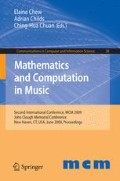Abstract
This paper presents a method for analyzing expressive timing data from music performances. The goal is to uncover rules which explain a performer’s systematic timing manipulations in terms of structural features of the music such as form, harmonic progression, texture, and rhythm. A multi-tiered approach is adopted, in which one first identifies a continuous tempo curve by performing non-linear regression on the durations of performed time spans at all levels in the metric hierarchy. Once the effect of tempo has been factored out, subsequent tiers of analysis examine how the performed subdivision of each metric layer (e.g., quarter note) typically deviates from an even rendering of the next lowest layer (e.g., two equal eighth notes) as a function of time. Structural features in the music are identified that contribute to a performer’s tempo fluctuations and metric deviations.
Access this chapter
Tax calculation will be finalised at checkout
Purchases are for personal use only
Preview
Unable to display preview. Download preview PDF.
References
Gabrielsson, A.: Music Performance. In: Deutsch, D. (ed.) The Psychology of Music, 2nd edn. Academic Press, San Diego (1999)
Widmer, G., Goebl, W.: Computational Models of Expressive Music Performance: The State of the Art. Journal of New Music Research 33, 203–216 (2004)
Lerdahl, F., Jackendoff, R.S.: A Generative Theory of Tonal Music. MIT Press, Cambridge (1983)
London, J.: Hearing in Time: Psychological Aspects of Musical Meter. Oxford University Press, Oxford (2004)
Todd, N.P.M.: A Computational Model of Rubato. Contemporary Music Review 3, 69–88 (1989)
Honing, H.: Computational Modeling of Music Cognition: A Case Study on Model Selection. Music Perception 23, 365–376 (2006)
Clarke, E.F.: Generative Principles in Music Performance. In: Sloboda, J.A. (ed.) Generative Processes in Music: The Psychology of Performance, Improvisation, and Composition. Clarendon Press, Oxford (1988)
Friberg, A.: A Quantitative Rule System for Musical Performance. Doctoral dissertation, Royal Institute of Technology, Stockholm (1995)
Widmer, G.: Machine Discoveries: A Few Simple, Robust Local Expression Principles. Journal of New Music Research 31, 37–50 (2002)
Widmer, G., Tobudic, A.: Playing Mozart by Analogy: Learning Multi-Level Timing and Dynamics Strategies. Journal of New Music Research 32, 259–268 (2003)
Todd, N.P.M.: A Model of Expressive Timing in Tonal Music. Music Perception 3, 33–58 (1985)
Specht, D.F.: A General Regression Neural Network. IEEE Transactions on Neural Networks 2, 568–576 (1991)
Specht, D.F.: Probabilistic and General Regression Neural Networks. In: Chen, C.H. (ed.) Fuzzy Logic and Neural Network Handbook. McGraw-Hill, New York (1996)
Parzen, E.: On Estimation of a Probability Density Function and Mode. Annals of Mathematical Statistics 33, 1065–1076 (1962)
Clarke, E.F.: Rhythm and Timing in Music. In: Deutsch, D. (ed.) The Psychology of Music, 2nd edn. Academic Press, San Diego (1999)
Farbood, M.M.: A Quantitative, Parametric Model of Musical Tension. Doctoral dissertation. MIT, Cambridge, MA (2006)
Author information
Authors and Affiliations
Editor information
Editors and Affiliations
Rights and permissions
Copyright information
© 2009 Springer-Verlag Berlin Heidelberg
About this paper
Cite this paper
Mavromatis, P. (2009). A Multi-tiered Approach for Analyzing Expressive Timing in Music Performance. In: Chew, E., Childs, A., Chuan, CH. (eds) Mathematics and Computation in Music. MCM 2009. Communications in Computer and Information Science, vol 38. Springer, Berlin, Heidelberg. https://doi.org/10.1007/978-3-642-02394-1_18
Download citation
DOI: https://doi.org/10.1007/978-3-642-02394-1_18
Publisher Name: Springer, Berlin, Heidelberg
Print ISBN: 978-3-642-02393-4
Online ISBN: 978-3-642-02394-1
eBook Packages: Computer ScienceComputer Science (R0)

